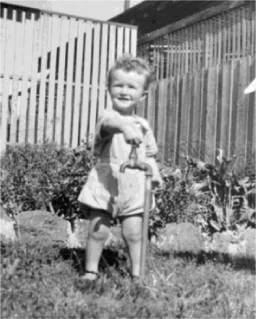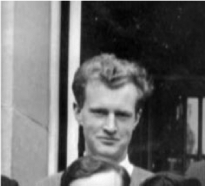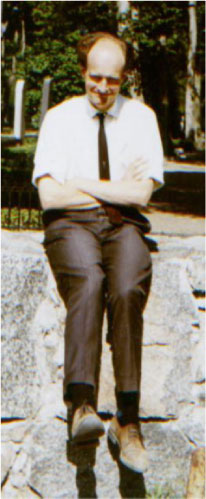Foreword
Australian Journal of Chemistry 65(7) 695-697 https://doi.org/10.1071/CH12304
Published: 2 August 2012
This special issue of the Australian Journal of Chemistry is dedicated to Allan White on the occasion of his 75th birthday, and to celebrate his contribution to Australian chemistry through his achievements in inorganic chemistry, as well as his extensive collaborations. This journal is especially appropriate for such a tribute given that Allan has published ~640 papers in its pages since 1964. That represents some 5.7% of the Journal’s total papers and notes since that time.
The Early Years
Allan Henry White was born in Melbourne and lived in Essendon during the war years, where he developed a lifelong preference for the Bombers Football Club. His father was a Works Foreman on the Victorian Railways and, as with many occupations in that era, his career required postings in a number of country towns. Allan’s primary education occurred in Essendon (Aberfeldie), Sale and Seymour, and secondary at Seymour and Hamilton High Schools, where he was dux. Classes were generally small, and the teaching mostly excellent, and, in due course, Allan progressed to Melbourne University on a Victorian State Education Department ‘secondary studentship’. This provided the necessary fees and living allowance to undertake BSc and DipEd degrees, in return for 3 years teaching. Fortunately, his father concurrently took up an appointment at Newport Workshops requiring the family’s return to Essendon.

|

|
Teaching
Allan’s first (brief) appointment, at age 21 (1959), was at a leading Melbourne High School. This was followed after a few weeks by a peremptory (and serendipitous) secondment to the Victorian School of Forestry at Creswick to teach tertiary diploma Chemistry (first and some second year) and Physics (first year). This was possible because his BSc entailed (somewhat unusually) a full major in Chemistry, with sub majors in Physics and Maths. Lectures were delivered to classes of ~10–12, the school complement totalling about 30 residential inmates. Among them, in the final years, surprisingly, old comrades from his National Service platoon! Assessment of Chemistry and Physics was undertaken at first year University standard by external assessors from Melbourne University, Alan Buchanan and JS Rogers. During the long vacations (on a normal secondary school year), a small research project was undertaken with the former.
University of Melbourne
After 3 years (1959–61) at the Forestry School, Allan returned to Melbourne University to undertake postgraduate study for an Honours year (1962), then PhD (1963–66) in inorganic chemistry under the supervision of the newly appointed Professor Ray Martin. The theme of the work was the iron(III) dithiocarbamate spin-crossover and provided the first of his papers to be published in the Australian Journal of Chemistry.[ 1 ] This occurred during the burgeoning of the inorganic renaissance, when many newly available physical techniques were brought to bear on inorganic problems. Ray Martin was a broad-minded supervisor and encouraged and enabled stimulating collaborations with a wide variety of experts associated with diverse techniques and institutions, relevant to the many dimensions of the basic problem. In the course of these adventures, Allan undertook his first single crystal X-ray study[ 2 ] in association with Bernard Hoskins, newly appointed at Melbourne from postdoctoral study with Nobel Laureate Dorothy Hodgkin. Allan became persuaded of the power of basic structural knowledge as a prelude to the more general study of chemical phenomena very early on in his career. During this period, he undertook some lecturing and lab-class supervision at Melbourne. At the end of his PhD studies, after an interview with visiting Professor Noel Bayliss, an appointment was offered at the University of Western Australia to fill a recent vacancy, requiring almost immediate teaching of first year in particular. It is interesting to reflect on how things were done in the past!
Independent Research Career
Newlyweds Allan and Jan arrived in Perth in April 1966, following Allan’s appointment as a lecturer in Physical Chemistry at the University of Western Australia. Initially, his research evolved into metal dithiocarbamate and potential spin-crossover complexes more broadly. Feeling the need to rectify the fact that he had not yet undertaken any postdoctoral study, he spent a 1967–68 summer vacation spell with Ray Golding, who had been involved in some broad-line NMR work on the dithiocarbamates, while at DSIR Wellington, New Zealand. At this stage Ray’s book Applied Quantum Mechanics was at the proof stage, and a fruitful and valuable didactic experience was enjoyed, together with Ekkehard Sinn, also at Department of Scientific and Industrial Research on a similar venture, in working through the proofs and their implicit exercises under Ray’s tutelage. The exercise was extended the following summer (1968–69), when Ray had assumed the chair in Physical chemistry at the University of New South Wales. This entailed the first of many trans-Nullarbor expeditions. These were undertaken with Allan’s first PhD students, an economical way of spreading scarce travel funds when fares were not cheap. These trips have remained a memory of Allan’s students from those times and the subject of a very entertaining lecture at a celebration of his chemistry on his retirement from the University of Western Australia.
Following up on a suggestion of Ray Martin, 1970 was spent on a Nuffield fellowship at Cambridge with David Buckingham – a collaboration from which Allan’s most highly cited paper emerged.[ 3 ] This entailed the study of the scattering of light from gases – a nice irony given that the bulk of Allan’s career would depend on the scattering of X-rays from crystals!
UWA Crystallography Centre
During the late 1960s, Allan’s interest in single crystal X-ray studies had also developed, aided by encouragement from UWA. Prior to leaving for Cambridge, an application for a four-circle diffractometer for Chemistry was made, more in hope than expectation, as such an instrument already existed in the Physics department. It was a pleasant surprise on return to find the application successful. With two such instruments on campus, the decision was taken (in accordance with the ARH Cole Plan), to house them in a newly established Crystallography Centre, located in Physics, in happy proximity to the excellent Physics workshop, but entailing a trek across James Oval from Chemistry. Many of us recall with fondness the sight of Allan walking across the Oval while kicking gumnuts, and occasionally avoiding swooping magpies. If a nut strayed out of reach he would simply pull another from his pockets and continue his sport.

|
The Centre was established as a multidisciplinary entity, with an academic complement of half of a physicist, Ted Maslen (another associate of Dorothy Hodgkin’s), Allan as a chemist, notionally also half a mineralogist and half a biologist, and a technician. However, economic priorities dictated that the position be completely filled at the expense of the biologist, by Syd Hall, who became the Centre’s computational genius. The intention was that the Centre (one of three on campus) should operate for the benefit of the University, and it soon became evident that indeed there was a need for single crystal X-ray structure determination within the School of Chemistry. Allan was happy to participate in such endeavours, at the time single crystal structural determinations were very labour and computation intensive, but gradually they became less so, as instrumentation and computation developed and improved in reliability. Further, generous support from within Chemistry from interested individuals enabled the employment of Colin Raston post-PhD in a collaborative capacity. This model worked well, attracting support from the Australian Research Grants Committee in the following year, and in 1976, this was extended to encompass similar collaborations in support of individuals in other institutions across the nation, in return for appropriate instrumentation and personnel support. This arrangement persisted for 20 years (anchored by Brian Skelton), by which time instrumentation and expertise in the technique had become widespread. The situation also provided a solid underpinning for Allan’s own interests, which became skewed accordingly toward ‘structural chemistry’.
The Chemistry
Through the 1960s and later, single crystal X-ray studies in inorganic and coordination chemistry had been dominated by transition metal complexes, and large tracts of some very basic main group chemistry remained structurally ill defined. PhD projects that were undertaken under Allan’s supervision, sometimes co-supervised with other colleagues, became slanted thus, growing out of a seminal structure in the late 1970s. The interesting oligomeric arrays obtained with complexes of univalent coinage metal halides with the fashionable tertiary phosphine ligands were capturing imagination widely. There was, however, seemingly negligible interest in any nitrogen-base analogues, despite some having been synthesised as far back as the nineteenth century. The structure of the 1 : 1 adduct of copper(I) iodide with pyridine was elucidated,[ 4 ] showing it to be a ‘cubane’ tetramer, thereby stimulating further activity in related Group V ligand–coinage metal complexes. In time, this broadened into the definition of arrays of ‘simple’ (‘baseline’) complexes of important nitrogen bases with main group, ‘closed shell’ metal salts, including those of the rare earths, converging with the interests of colleagues Dave Kepert and Jack Harrowfield. Here, the prime interest was structural, defining coordination numbers and environments, and molecularity. The majority of these compounds were (at least at that time) ‘spectroscopically silent’, although collaboration with experts and kindred spirits meant that these materials were examined spectroscopically. Allan’s projects were rarely rigidly defined at the outset, much of the work being in virgin territory, and accommodating the philosophy that, given their heads, good students would take a field and make it their own. Allan possessed a trademark reluctance to publish material until late in the project, when it could be appreciated in its entirety. Work was usually submitted as a multiple paper ‘brick’ that told as much of the story, as completely as possible, in one hit, eliminating any need for any associated review, and usually done in parallel with the preparation of the thesis. With some journals, this approach caused difficulties with indigestibility in refereeing and the editorial process. Initially sympathetic reception was found with the Australian Journal of Chemistry and its remarkable editors Bob Schoenfeld and his successor John Zdysziewicz, both creatively cooperative and committed to high standards. With their assistance and guidance numerous ‘bricks’ found a home in that venue on an approximately annual basis throughout the 1980s and 1990s.[ 5 ] – [ 14 ]
Service
Allan’s work has been recognised locally through the Royal Australian Chemical Institute via the Smith and Burrows awards, and one of the inaugural Citations: ‘For services to chemical crystallography, particularly … in developing countries’; his research group was almost always multinational in character and, although never large, it was usually around the desideratum of a handful of good and enthusiastic workers. An ISI ‘Highly Cited Scientist’ (Citation Laureate, Chemistry, Australia, 2004), co-authoring nearly 1850 publications grounded in more than 5000 structure determinations (2012), his ‘h-index’ of 68 in 2010 placed Allan in the top 250 of that RSC world listing.
Outside of chemistry, Allan has had significant musical interests; during his student years, he was known to disappear in the direction of St Paul’s cathedral, spending quality time learning the organ with Lance Hardy. Soon after arriving in Perth, he was acting organist at St George’s cathedral for some months, during a hiatus in the occupancy of that position. Perceiving his skills were deteriorating during the 1970s he resolved to do something positive about it and thus he completed an honours performance degree part-time through the 1980s, becoming the UWA ceremonial organist for about 5 years around 1990. It is notable that Allan gave an opening recital in the Perth concert hall at the commencement of the 1987 XIV International Union of Crystallography Congress.
Allan retired in August 2007, shortly after the closure of the Crystallography Centre, which, having limited teaching function, was held to be no longer compatible with UWA’s developing business model. Ambitious retirement plans were rudely scuppered by the diagnosis of myeloma, at present acceptably stable in remission (thanks to James, Frank, Dermot, Michael, Bill, Peter, Marek, David and, of course, Jan), but with consequent ‘collateral damage’ inhibiting travel. Having a significant quantity of unpublished material still remaining, Allan is agreeably occupied writing that up in the ambience of UWA Chemistry’s new Bayliss Building.
We wish him many happy returns on the occasion of his 75th birthday.
George Koutsantonis and Yang Kim
References
[1] A. White, R. Roper, E. Kokot, H. Waterman, R. Martin, Aust. J. Chem. 1964, 17, 294.| Crossref | GoogleScholarGoogle Scholar | 1:CAS:528:DyaF2cXnt1GksQ%3D%3D&md5=b6392ba0d5454d1cae9fe547f36fbb7eCAS |
[2] B. F. Hoskins, R. L. Martin, A. H. White, Nature 1966, 211, 627.
| Crossref | GoogleScholarGoogle Scholar | 1:CAS:528:DyaF28XkslOqs78%3D&md5=9582d08bd6dd7d530fde9b0d991c874fCAS |
[3] M. P. Bogaard, A. D. Buckingham, R. K. Pierens, A. H. White, J. Chem. Soc. Faraday Trans. I 1978, 74, 3008.
| Crossref | GoogleScholarGoogle Scholar | 1:CAS:528:DyaE1MXnvVGmuw%3D%3D&md5=47d4590c42dd366672cb78e0906e6911CAS |
[4] C. L. Raston, A. H. White, J. Chem. Soc., Dalton Trans. 1976, 2153.
| Crossref | GoogleScholarGoogle Scholar | 1:CAS:528:DyaE2sXmtl2ntA%3D%3D&md5=803bbaa3a0378e6221d2cafbeec8a0caCAS |
[5] Australian Journal of Chemistry 1981, 34(10), 2061–2193.
[6] Australian Journal of Chemistry 1989, 42(1), 885–947.
[7] Australian Journal of Chemistry 1989, 42(6), 79–207.
[8] Australian Journal of Chemistry 1994, 47(2), 321–410.
[9] Australian Journal of Chemistry 1996, 49(1), 27–154.
[10] Australian Journal of Chemistry 1996, 49(10), 1029–1156.
[11] Australian Journal of Chemistry 1997, 50(6), 539–682.
[12] Australian Journal of Chemistry 1998, 51(4), 285–336.
[13] Australian Journal of Chemistry 1998, 51(8), 707–794.
[14] Australian Journal of Chemistry 1999, 52(6), 437–620.


